The 1992 Mercedes-Benz 500, a symbol of luxury and engineering prowess, carved its place in automotive history as a benchmark for opulence and performance. This sedan, with its sleek design and powerful engine, was a testament to Mercedes-Benz’s commitment to crafting vehicles that exuded sophistication and driving pleasure.
The 1992 500 was more than just a car; it was a statement of success and refinement. Its powerful V8 engine delivered exhilarating performance, while its luxurious interior offered unparalleled comfort and amenities. This model embodied the essence of Mercedes-Benz, a brand synonymous with quality, craftsmanship, and innovation.
Overview

The 1992 Mercedes-Benz 500, also known as the W140 500 SEL, is a luxury sedan that represents a significant chapter in the history of Mercedes-Benz. This model, introduced in 1991, was the successor to the W126 series and marked a shift in the brand’s design philosophy, offering a more opulent and technologically advanced experience.
It was positioned as a flagship model, embodying the pinnacle of luxury and engineering excellence that Mercedes-Benz was known for.The 1992 Mercedes-Benz 500 was a testament to the brand’s commitment to engineering and design innovation. Its design was a departure from the previous generation, showcasing a more angular and imposing aesthetic.
The car was renowned for its luxurious interior, advanced features, and powerful engine, making it a popular choice among discerning drivers seeking a combination of comfort, performance, and prestige.
Key Features and Specifications
The 1992 Mercedes-Benz 500 featured a range of advanced features and specifications that contributed to its reputation as a luxurious and technologically advanced vehicle.
- Engine:The 500 SEL was powered by a 5.0-liter V8 engine, producing 322 horsepower and 339 lb-ft of torque. This engine provided ample power and smooth acceleration, making it a capable performer on the road.
- Transmission:The engine was mated to a four-speed automatic transmission, providing smooth gear changes and effortless driving experience.
- Suspension:The 500 SEL featured a sophisticated independent suspension system that provided a comfortable ride and excellent handling characteristics. This suspension system included a multi-link rear suspension design, which contributed to the car’s stability and ride quality.
- Interior:The interior of the 1992 Mercedes-Benz 500 was designed to provide a luxurious and comfortable environment. It featured premium leather upholstery, wood trim, and a range of advanced features, including automatic climate control, power seats, and a premium sound system.
- Safety Features:Safety was a top priority for Mercedes-Benz, and the 1992 500 SEL was equipped with a comprehensive suite of safety features, including anti-lock brakes (ABS), airbags, and a reinforced passenger compartment.
Design and Styling
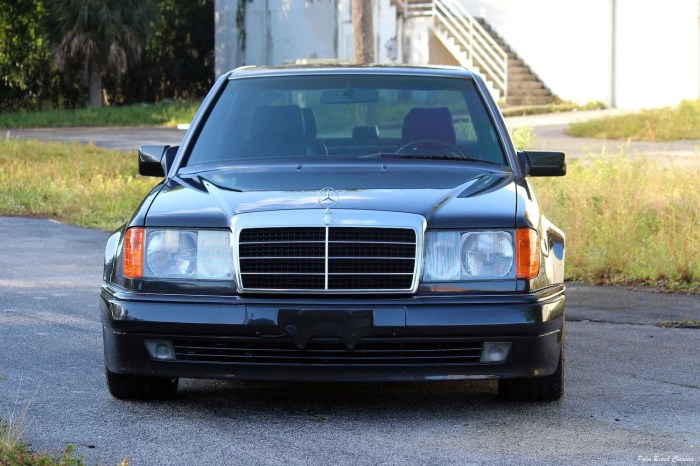
The 1992 Mercedes-Benz 500, known internally as the W140, is a car that embodies the elegance and engineering prowess that Mercedes-Benz is known for. Its design was a departure from the more angular styling of its predecessors, embracing a more rounded and flowing aesthetic that defined the era.
Exterior Design
The 500’s exterior design is a testament to the brand’s commitment to both luxury and performance. The car features a long, sweeping hood, a prominent grille with the iconic three-pointed star, and a sculpted body that flows seamlessly from front to rear.
The design is characterized by its smooth curves, rounded edges, and the absence of sharp angles. This approach creates a sense of both power and refinement, making the 500 a visually striking car even today.
Interior Design
The interior of the 1992 500 is a haven of luxury and comfort. High-quality materials, including supple leather, wood trim, and plush carpets, adorn the cabin. The dashboard is ergonomically designed, with all controls within easy reach of the driver.
The spacious cabin provides ample legroom and headroom for both front and rear passengers, contributing to a feeling of opulence and spaciousness. The 500’s interior is a testament to the brand’s commitment to providing a truly luxurious driving experience.
Comparison with Other Mercedes-Benz Models
The 1992 500’s design reflects the evolution of Mercedes-Benz’s styling language during the 1990s. Compared to earlier models like the W126 S-Class, the 500 features a more rounded and aerodynamic design. This shift in design philosophy was influenced by the increasing focus on aerodynamics and fuel efficiency during the era.
The 1992 Mercedes-Benz 500 was a symbol of luxury and performance, a stark contrast to the more affordable, yet still stylish, 1988 Chrysler LeBaron. If you’re looking for a blast from the past, check out 1988 Chrysler LeBaron: A Look Back at the 80s Classic for a nostalgic trip down memory lane.
While the LeBaron might not have the same pedigree as the 500, it offered a unique blend of comfort and practicality that appealed to a different segment of the market.
The 500’s design also foreshadowed the more streamlined and contemporary aesthetics that would become prevalent in later Mercedes-Benz models, such as the W220 S-Class.
Engine and Performance
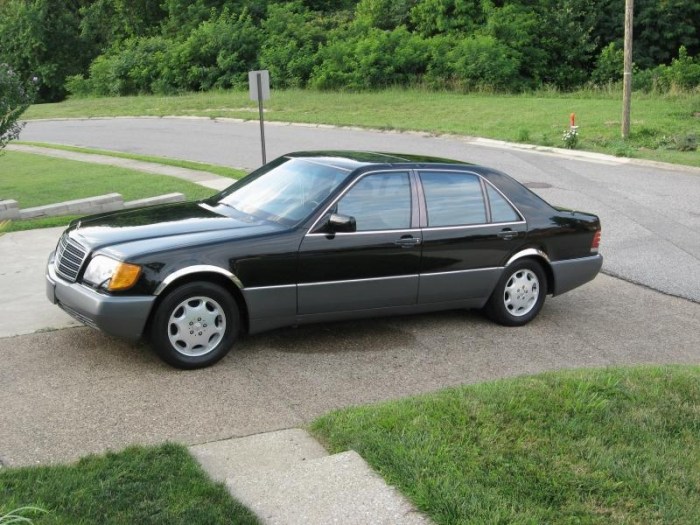
The 1992 Mercedes-Benz 500 was powered by a robust engine that delivered both power and refinement, making it a standout performer in its class.
Engine Specifications
The heart of the 1992 500 was a 5.0-liter naturally aspirated V8 engine. This engine was known for its smooth operation and impressive power output. It produced 322 horsepower at 5,600 rpm and 339 lb-ft of torque at 4,000 rpm.
The engine was mated to a four-speed automatic transmission, which provided smooth and responsive gear changes.
Performance Characteristics
The 1992 500 offered a blend of performance and comfort. Its acceleration was smooth and effortless, with a 0-60 mph time of around 7 seconds. The car’s handling was precise and composed, thanks to its independent suspension and responsive steering.
The braking system provided strong stopping power, ensuring confidence in any situation.
Comparison to Contemporary Luxury Sedans
The 1992 500 was a formidable competitor in the luxury sedan segment. It offered a compelling combination of power, handling, and comfort, placing it among the top performers of its time. Compared to rivals like the BMW 7 Series and the Lexus LS 400, the 500 stood out for its powerful engine, refined driving experience, and distinctive styling.
Features and Technology
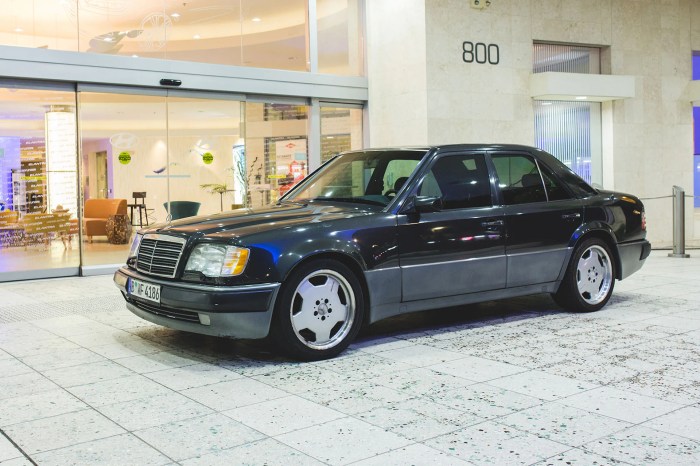
The 1992 Mercedes-Benz 500, a flagship model of its time, offered a comprehensive suite of features, blending luxury, performance, and technological advancements. This blend of features catered to the discerning driver seeking a blend of comfort, safety, and technological sophistication.
Safety Features
Safety was a paramount concern in the design of the 1992 500. Mercedes-Benz implemented a robust set of safety features, ensuring the well-being of both the driver and passengers.
- Anti-lock Braking System (ABS):The 500 featured ABS as standard equipment, enhancing braking performance by preventing wheel lock-up during hard braking, contributing to improved vehicle control and reduced stopping distances.
- Electronic Stability Program (ESP):While not standard in 1992, the 500 could be equipped with an early form of ESP, which used sensors to detect potential loss of control and electronically intervene to stabilize the vehicle.
- Airbags:The 1992 500 came equipped with dual front airbags, offering an additional layer of protection for the driver and front passenger in the event of a collision.
- Safety Belts:The 500 featured three-point safety belts for all seating positions, along with a driver’s side seatbelt pretensioner, which automatically tightened the belt in a crash scenario, reducing the risk of injury.
Comfort and Convenience Features
The 1992 Mercedes-Benz 500 was renowned for its luxurious interior and advanced comfort features. These features were designed to enhance the driving experience and provide a sense of well-being.
- Leather Upholstery:The interior of the 500 was lavishly appointed with premium leather upholstery, offering both comfort and a sense of luxury.
- Power Seats:The 500 featured power-adjustable front seats with multiple settings, allowing drivers and passengers to find their ideal seating position.
- Automatic Climate Control:The 500 came equipped with automatic climate control, which maintained a comfortable temperature inside the cabin, regardless of external conditions.
- Power Windows and Locks:The 500 offered power windows and door locks for convenience and ease of use.
- Sunroof:The 500 could be equipped with a sunroof, allowing occupants to enjoy fresh air and sunlight.
- Cruise Control:Cruise control allowed the driver to maintain a constant speed, reducing fatigue on long journeys.
Entertainment Features, 1992 Mercedes-Benz 500
The 1992 500 provided a range of entertainment options, enhancing the driving experience for both the driver and passengers.
- AM/FM Stereo:The 500 featured a standard AM/FM stereo system, allowing occupants to enjoy their favorite radio programs.
- Cassette Player:A cassette player was also standard equipment, enabling playback of audio tapes.
- Optional CD Player:For those seeking more advanced audio options, a CD player was available as an optional extra.
Technological Advancements
The 1992 Mercedes-Benz 500 incorporated several technological advancements that were notable for its time.
- Electronic Fuel Injection:The 500 featured a sophisticated electronic fuel injection system, which optimized fuel delivery for improved performance and fuel efficiency.
- Electronic Engine Management System:The 500’s engine was controlled by an advanced electronic management system, constantly adjusting engine parameters for optimal performance and emissions control.
- Anti-theft System:The 500 was equipped with an electronic anti-theft system, deterring potential theft.
Reliability and Ownership
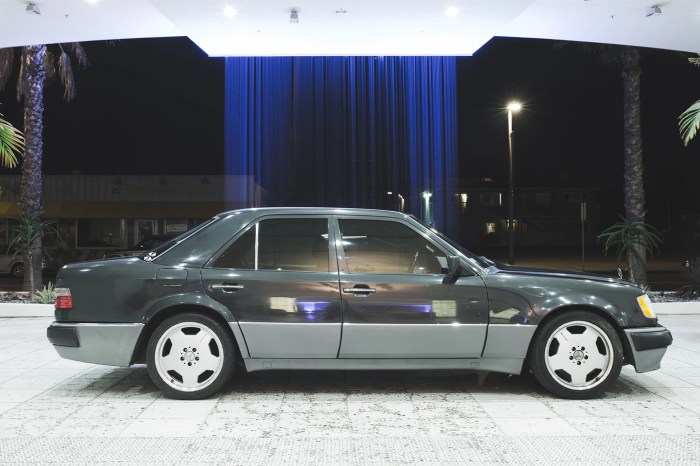
The 1992 Mercedes-Benz 500 is renowned for its robust build quality and impressive longevity, making it a desirable classic car for enthusiasts. However, owning a vintage luxury vehicle comes with its own set of considerations, including potential maintenance needs and associated costs.
Common Maintenance Issues
While the 1992 500 is generally a reliable car, certain areas may require attention over time.
The 1992 Mercedes-Benz 500, a timeless masterpiece, embodies the elegance and engineering prowess that defines the brand. This car, with its powerful V8 engine and luxurious interior, is a testament to the enduring appeal of classic cars. The 1992 Mercedes-Benz 500 remains a sought-after collectible, capturing the essence of automotive excellence from a bygone era.
- Suspension Components:The suspension system, particularly the ball joints, control arms, and bushings, can wear out over time, requiring replacement. These components are prone to wear and tear due to the car’s weight and age.
- Engine Cooling System:The cooling system, including the radiator, hoses, and thermostat, should be regularly inspected and maintained to prevent overheating. Older vehicles are more susceptible to leaks and corrosion in the cooling system.
- Electrical System:The electrical system, including the wiring, sensors, and actuators, can be prone to issues due to age and exposure to the elements. Electrical problems can manifest as intermittent issues or complete failures.
It is essential to address these issues promptly to prevent further damage and ensure the car’s continued reliability.
The 1992 Mercedes-Benz 500 was a luxury sedan that epitomized opulence and performance. But for those seeking a more practical and affordable option, the compact car segment offered compelling choices. One such car that left a lasting mark was the 2001 Volkswagen Jetta: A Look Back at a Compact Car Icon.
While the Jetta offered a more accessible experience, the 1992 Mercedes-Benz 500 remained a symbol of automotive excellence for those who desired the finer things in life.
Cost of Ownership
The cost of owning a 1992 Mercedes-Benz 500 can vary depending on factors such as location, driving habits, and maintenance practices.
- Fuel Economy:The 500’s 5.0-liter V8 engine is known for its power but is not particularly fuel-efficient. Expect to achieve an average of 14-18 miles per gallon in mixed driving conditions.
- Insurance:Insurance premiums for a classic car can vary significantly based on factors such as the car’s value, your driving record, and the insurance company. It’s advisable to obtain quotes from multiple insurers to find the best coverage at a competitive price.
- Repairs:Repair costs for a vintage Mercedes-Benz can be higher than for modern cars due to the specialized parts and labor required. It’s important to seek out reputable mechanics experienced in working on classic vehicles.
While the 1992 500 is a desirable classic car, it’s essential to factor in the potential costs associated with owning and maintaining a vintage vehicle.
Historical Context
The 1992 Mercedes-Benz 500, officially known as the W140 model, emerged during a period of significant change in the global automotive landscape. The early 1990s witnessed a confluence of economic, social, and technological trends that shaped the design, development, and reception of this luxurious sedan.This era was marked by a growing demand for sophisticated and technologically advanced vehicles, fueled by rising global prosperity and a desire for enhanced comfort and safety features.
The 1992 Mercedes-Benz 500, with its opulent interior, powerful engine, and advanced technology, epitomized this trend.
The 1992 Mercedes-Benz 500, with its powerful V8 engine and opulent interior, was a symbol of automotive excellence. But for those seeking the ultimate in luxury, the 1990 Rolls-Royce Silver Spur: Luxury Redefined offered an unparalleled experience. The Silver Spur, with its hand-crafted details and legendary ride, redefined luxury, setting a standard that the Mercedes-Benz 500, while impressive, couldn’t quite match.
Economic and Social Influences
The global economy in the early 1990s was characterized by a period of relative stability following the recession of the late 1980s. This stability led to increased consumer spending, particularly on luxury goods, contributing to a surge in demand for high-end automobiles.
Furthermore, societal values shifted towards a greater appreciation for luxury and status symbols. This trend was particularly pronounced in emerging economies, where the newly affluent sought to express their success through conspicuous consumption, including the purchase of luxury vehicles.
“The 1992 Mercedes-Benz 500 was a symbol of success and affluence, appealing to a growing segment of consumers who desired the ultimate in luxury and performance.”
Automotive Design and Technology Trends
The early 1990s witnessed significant advancements in automotive design and technology. This era saw the rise of aerodynamic styling, characterized by rounded contours and sleek lines, which improved fuel efficiency and enhanced driving performance. The 1992 Mercedes-Benz 500 embodied this trend with its aerodynamically sculpted body, contributing to its impressive fuel economy for a vehicle of its size.
“The 1992 Mercedes-Benz 500 showcased the growing trend towards aerodynamic design, emphasizing efficiency and performance.”
Moreover, the 1990s marked a period of rapid technological innovation in the automotive industry. Advancements in engine technology, including the introduction of electronic fuel injection and variable valve timing, led to more powerful and fuel-efficient engines. The 1992 Mercedes-Benz 500 featured a powerful 5.0-liter V8 engine with electronic fuel injection, delivering exceptional performance while maintaining a reasonable level of fuel efficiency.
The 1992 Mercedes-Benz 500, a symbol of luxury and engineering prowess, is a timeless classic. While it might not be the most practical choice for hauling heavy loads, its elegance and performance are undeniable. For those seeking a workhorse with a rugged charm, consider the 2002 GMC 1500: A Classic Truck Review.
This full-size pickup truck offers ample power and towing capacity, making it a perfect choice for those who need a vehicle that can handle any task. Returning to the Mercedes-Benz 500, its iconic design and refined interior make it a statement piece, even decades later.
Additionally, the development of electronic stability control (ESC) systems significantly enhanced vehicle safety. The 1992 Mercedes-Benz 500 was one of the first vehicles to feature ESC as standard equipment, demonstrating the brand’s commitment to safety innovation.
“The 1992 Mercedes-Benz 500 reflected the technological advancements of the early 1990s, incorporating innovative features like electronic fuel injection and electronic stability control.”
Cultural Impact
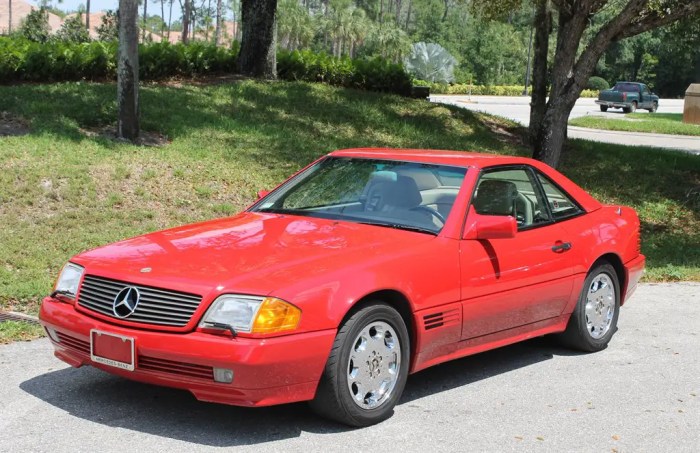
The 1992 Mercedes-Benz 500, with its opulent design and powerful engine, quickly became a symbol of success and luxury. Its presence on roads and in popular culture solidified its status as a car for the elite, influencing perceptions of the Mercedes-Benz brand and shaping the aspirations of many.
Association with Lifestyles
The 1992 500 was associated with a particular lifestyle, often linked to business executives, entrepreneurs, and those with a discerning taste for luxury. It was seen as a vehicle that conveyed power, prestige, and a sense of accomplishment. The car’s imposing presence and sophisticated features contributed to its image as a symbol of status and achievement.
Portrayal in Media
The 1992 500 made frequent appearances in movies, television shows, and other media, further cementing its association with success and luxury. Its sleek lines and distinctive grille became instantly recognizable, often representing characters who possessed wealth, influence, and a refined sense of style.
The 1992 500’s presence in movies and TV shows helped solidify its image as a vehicle for the successful and powerful.
Impact on Mercedes-Benz Image
The 1992 500 played a crucial role in reinforcing Mercedes-Benz’s reputation as a leading luxury car manufacturer. Its success in the market, its association with a prestigious lifestyle, and its frequent appearances in popular culture all contributed to the brand’s image as a symbol of quality, craftsmanship, and exclusivity.
Legacy and Influence
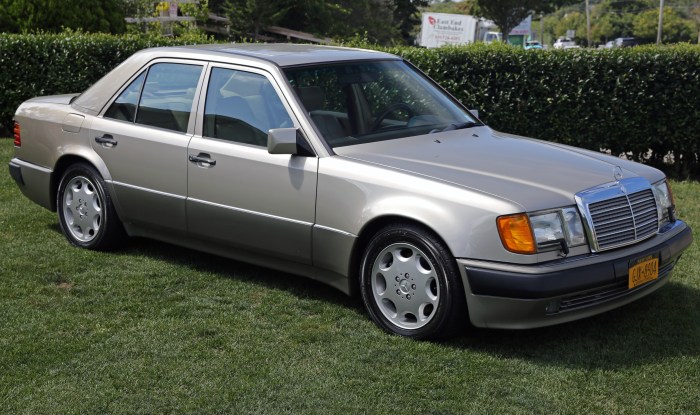
The 1992 Mercedes-Benz 500, a technological marvel for its time, left an indelible mark on the automotive industry, influencing subsequent Mercedes models and shaping the landscape of luxury car design and performance. Its innovations and enduring appeal continue to resonate with car enthusiasts and collectors today.
Impact on Mercedes-Benz Models
The 1992 500’s influence on future Mercedes-Benz models is evident in its design, technology, and performance. Its elegant yet robust design language, characterized by clean lines, flowing curves, and a powerful stance, laid the foundation for the distinctive aesthetic of subsequent Mercedes models.
The 500’s advanced technology, including its powerful V8 engine, sophisticated suspension, and advanced safety features, paved the way for the technological advancements that would become synonymous with Mercedes-Benz. This model’s success cemented Mercedes-Benz’s position as a leader in the luxury car segment and inspired the development of future iconic models like the S-Class and the E-Class.
Wrap-Up: 1992 Mercedes-Benz 500
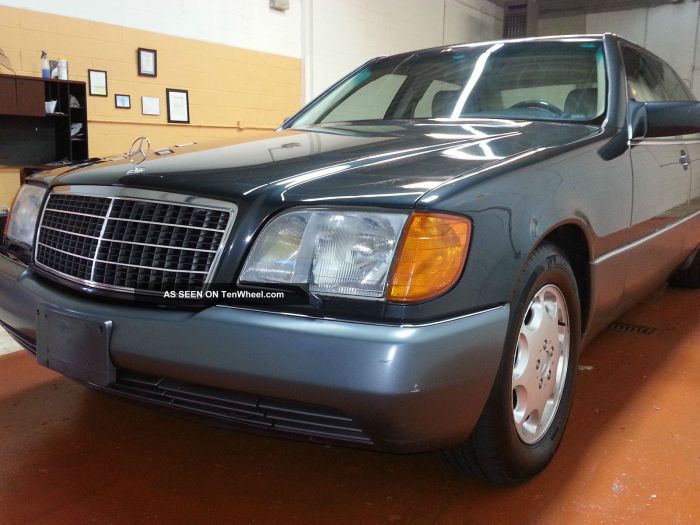
The 1992 Mercedes-Benz 500 remains a coveted classic, capturing the hearts of car enthusiasts and collectors alike. Its timeless design, powerful performance, and luxurious features have ensured its enduring appeal. This model continues to represent the pinnacle of automotive excellence, a testament to Mercedes-Benz’s legacy of crafting vehicles that stand the test of time.